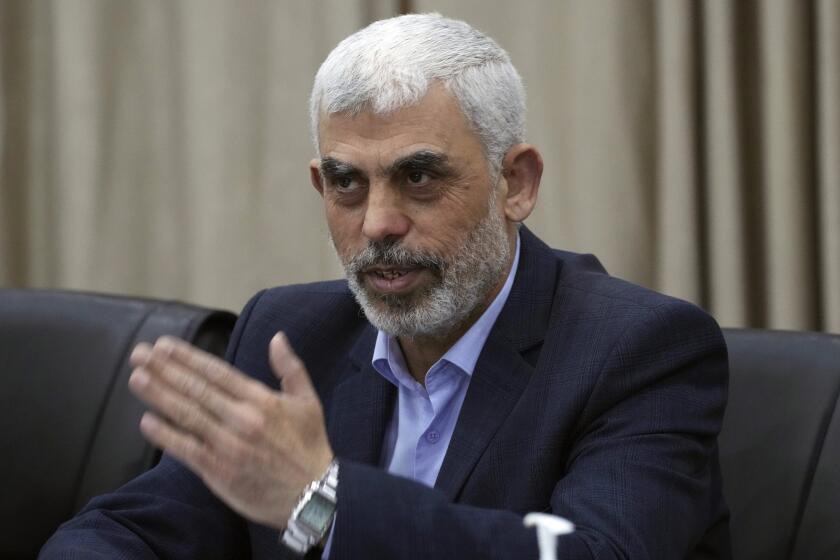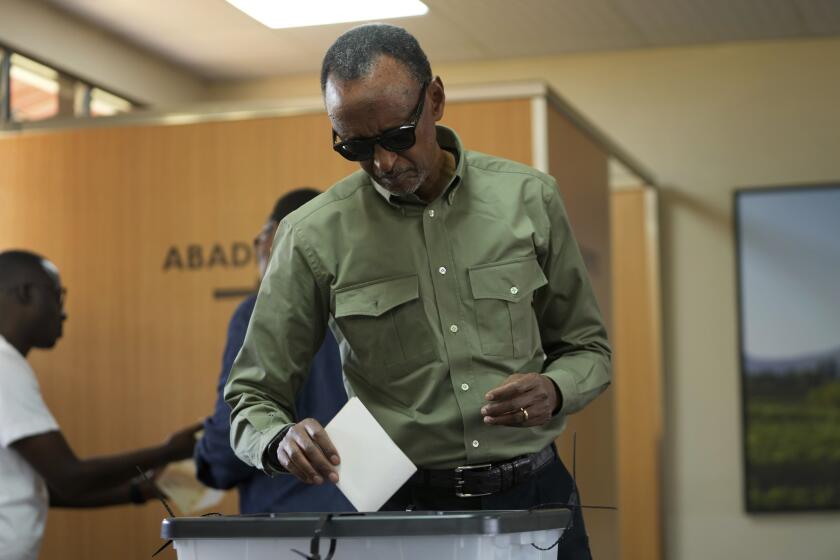$27 Million Pledged for De-Mining
Officials from 24 nations and international organizations pledged $27.2 million--including $7 million by the U.S.--for de-mining Afghanistan, as a two-day conference on rebuilding the country came to a close Tuesday.
Although the funds were welcomed by Afghan officials, they are a fraction of the $668 million over seven years that U.N. experts say is needed to eliminate the nation’s land mine and unexploded ordnance problem.
Ridding Afghanistan of these time bombs, or at least minimizing their ability to inflict damage, is an ambitious goal. By some estimates, as many as 10 million land mines and other unexploded munitions litter the Central Asian country after decades of war and instability.
An estimated 300 Afghans are killed every month by the deadly leftovers, including children scavenging for the 25 cents’ worth of metal in each mine, according to the United Nations. Half of the victims die instantly or succumb to their wounds on the way to doctors, who are often several days of hard travel away, land mine experts here say. That compares with about 30 people a month killed nowadays in Cambodia, a past poster child for anti-mine campaigns, the U.N. says.
At the conference in Tokyo, officials from contributing nations and Afghanistan pressed for a fast, concerted de-mining campaign. “The need for action is great,” said interim Afghan Prime Minister Hamid Karzai. “Our citizens are falling victim to them daily.”
Experts argue that the $668-million price tag compares favorably with the more than $700 million spent de-mining Kuwait after the 1991 Persian Gulf War and the $70 million spent so far in Kosovo, the Serbian province that sparked a battle between the North Atlantic Treaty Organization and Yugoslavia in 1999.
“Kosovo is a postage stamp,” said Richard Daniel Kelly, mine action program director with the Office of the U.N. Coordinator for Afghanistan. “It’s the size of one province in Afghanistan, and Afghanistan has 31 provinces.”
Money spent to de-mine the country has secondary benefits. With nearly 5,000 Afghans now working to identify and deactivate mines, the campaign ranks as the nation’s largest single source of employment, U.S. and U.N. officials say. A portion of the money pledged Tuesday by the United States, which is to be routed through the HALO Trust, a nonprofit de-mining group, is expected to employ 800 more.
Torek Farhadi, an economic advisor to the interim government, said mines take a huge psychological toll on Afghans, killing people years after fighting has stopped. In addition to preventing such tragedies, mine clearing allows refugees to cross back into Afghanistan, helps put farmland back into production and gives children and adults the confidence to walk roads to schools and markets, he added.
Some of the money pledged Tuesday is expected to go to UNICEF for an intensive education campaign timed to coincide with the scheduled reopening of schools in March. The campaign will cover what mines look like, how to avoid them and how to report them to authorities.
In the last six months, about $10 million in land mine detection equipment has been stolen, vandalized or destroyed in Afghanistan, officials said. Japan will spend $15.4 million to pay for new equipment.
The U.S. has refused to sign a 1997 international accord banning land mines, arguing that the weapons are necessary in certain places such as the border between North and South Korea. But Washington is reviewing its position, with a decision expected within a few months, a senior U.S. official said. He added that the government has destroyed about 3.3 million of its own stockpiled land mines and banned the weapons’ export. Karzai said Monday that his government plans to sign the accord.
The de-mining effort in Afghanistan comes amid a long-standing debate over the relative benefits of using people to defuse mines--creating jobs but putting workers at risk of injury or death--or spending scarce resources on new technology. At least 60 Afghans have been killed in de-mining operations in recent years, and several hundred have been wounded, experts say.
On the eve of the Tokyo conference, Japan weighed in with a strange-looking contraption that it said was a prototype robot capable of clearing mines. But a Japanese official at the gathering said a working model could be a decade away.
Searchers using metal-detecting devices often dig up soda cans and empty shell casings, and the problem has gotten worse as mine manufacturers use less metal and more plastic and ceramic in the devices. This has sparked research into X-ray and microwave technologies, ground-penetrating radar and a system that would turn microbes in the explosive material a luminescent color.
Deciding where to start de-mining in Afghanistan is a problem. The Russian government gave 350 battle plans, showing some minefields, to the Afghan government in the early 1990s, but they were lost. The Russians have now found 150 more maps that will be handed over to the U.N. de-mining authority, a senior U.N. official said. The U.S. has provided a list of 188 locations where it dropped cluster bombs, the official added.
According to U.N. estimates, more than 320 square miles of the country are riddled with mines, with nearly half that in heavily populated areas.
In some places, surveyors catalog where land mine accidents have occurred, and computers correlate the data with road, electricity and water grids. This allows planners to identify the worst dangers in the most populated areas.
“It’s impossible to clear every ordnance in Afghanistan,” said Donald K. Steinberg, deputy director of policy planning with the State Department. “The goal is to figure out where you’re going to get the best results quickly and also where there are no land mines.”
Unpopulated areas with lots of land mines may not be worth the effort.
“There are supposedly 20 million land mines in south Egypt, but no one ever goes there. So you put signs up and focus on higher priorities,” said a senior U.S. official.
More to Read
Sign up for Essential California
The most important California stories and recommendations in your inbox every morning.
You may occasionally receive promotional content from the Los Angeles Times.








